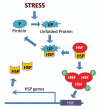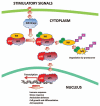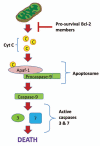Forever young: mechanisms of natural anoxia tolerance and potential links to longevity
- PMID: 20716943
- PMCID: PMC2952077
- DOI: 10.4161/oxim.3.3.12356
Forever young: mechanisms of natural anoxia tolerance and potential links to longevity
Abstract
While mammals cannot survive oxygen deprivation for more than a few minutes without sustaining severe organ damage, some animals have mastered anaerobic life. Freshwater turtles belonging to the Trachemys and Chrysemys genera are the champion facultative anaerobes of the vertebrate world, often surviving without oxygen for many weeks at a time. The physiological and biochemical mechanisms that underlie anoxia tolerance in turtles include profound metabolic rate depression, post-translational modification of proteins, strong antioxidant defenses, activation of specific stress-responsive transcription factors, and enhanced expression of cytoprotective proteins. Turtles are also known for their incredible longevity and display characteristics of "negligible senescence". We propose that the robust stress-tolerance mechanisms that permit long term anaerobiosis by turtles may also support the longevity of these animals. Many of the mechanisms involved in natural anoxia tolerance, such as hypometabolism or the induction of various protective proteins/pathways, have been shown to play important roles in mammalian oxygen-related diseases and improved understanding of how cells survive without oxygen could aid in the understanding and treatment of various pathological conditions that involve hypoxia or oxidative stress. In the present review we discuss the recent advances made in understanding the molecular nature of anoxia tolerance in turtles and the potential links between this tolerance and longevity.
Figures





Similar articles
-
Turtle anoxia tolerance: Biochemistry and gene regulation.Biochim Biophys Acta. 2015 Jun;1850(6):1188-96. doi: 10.1016/j.bbagen.2015.02.001. Epub 2015 Feb 7. Biochim Biophys Acta. 2015. PMID: 25662819 Review.
-
Anoxia tolerance in turtles: metabolic regulation and gene expression.Comp Biochem Physiol A Mol Integr Physiol. 2007 Jun;147(2):263-76. doi: 10.1016/j.cbpa.2006.03.019. Epub 2006 Sep 6. Comp Biochem Physiol A Mol Integr Physiol. 2007. PMID: 17035057 Review.
-
Development-specific transcriptomic profiling suggests new mechanisms for anoxic survival in the ventricle of overwintering turtles.J Exp Biol. 2020 Feb 17;223(Pt 4):jeb213918. doi: 10.1242/jeb.213918. J Exp Biol. 2020. PMID: 31862849
-
Exploring pathways of NO and H2S signaling in metabolic depression: The case of anoxic turtles.Comp Biochem Physiol A Mol Integr Physiol. 2021 Mar;253:110857. doi: 10.1016/j.cbpa.2020.110857. Epub 2020 Dec 1. Comp Biochem Physiol A Mol Integr Physiol. 2021. PMID: 33276130 Review.
-
Protein lysine methylation in the regulation of anoxia tolerance in the red eared slider turtle, Trachemys scripta elegans.Comp Biochem Physiol Part D Genomics Proteomics. 2020 Jun;34:100660. doi: 10.1016/j.cbd.2020.100660. Epub 2020 Feb 1. Comp Biochem Physiol Part D Genomics Proteomics. 2020. PMID: 32066095 Review.
Cited by
-
Hypoxia-induced reprogramming of the cardiac phenotype in American alligators (Alligator mississippiensis) revealed by quantitative proteomics.Sci Rep. 2019 Jun 13;9(1):8592. doi: 10.1038/s41598-019-45023-3. Sci Rep. 2019. PMID: 31197188 Free PMC article.
-
Induction of foxo3a protects turtle neurons against oxidative stress.Comp Biochem Physiol A Mol Integr Physiol. 2020 May;243:110671. doi: 10.1016/j.cbpa.2020.110671. Epub 2020 Feb 8. Comp Biochem Physiol A Mol Integr Physiol. 2020. PMID: 32044446 Free PMC article.
-
Cytoskeletal Arrest: An Anoxia Tolerance Mechanism.Metabolites. 2021 Aug 23;11(8):561. doi: 10.3390/metabo11080561. Metabolites. 2021. PMID: 34436502 Free PMC article. Review.
-
Extension of Health Span and Life Span in Drosophila by S107 Requires the calstabin Homologue FK506-BP2.J Biol Chem. 2016 Dec 9;291(50):26045-26055. doi: 10.1074/jbc.M116.758839. Epub 2016 Nov 1. J Biol Chem. 2016. PMID: 27803160 Free PMC article.
-
Targeting Mitochondrial Homeostasis: The Role of Acupuncture in Depression Treatment.Neuropsychiatr Dis Treat. 2023 Aug 1;19:1741-1753. doi: 10.2147/NDT.S421540. eCollection 2023. Neuropsychiatr Dis Treat. 2023. PMID: 37546517 Free PMC article. Review.
References
-
- Storey KB. Metabolic adaptations supporting anoxia tolerance in reptiles: recent advances. Comp Biochem Physiol B. 1996;113:23–35. - PubMed
-
- Storey KB. Anoxia tolerance in turtles: metabolic regulation and gene expression. Comp Biochem Physiol A. 2007;147:263–276. - PubMed
-
- Ultsch GR. The ecology of overwintering among turtles: where turtles overwinter and its consequences. Biol Rev Camb Philos Soc. 2006;81:339–367. - PubMed
-
- Churchill TA. Organ preservation for transplantation. In: Storey KB, editor. Functional Metabolism: Regulation and Adaptation. Hoboken, NJ: Wiley-Liss; 2004. pp. 383–413.
-
- Ma A, Qi S, Chen H. Antioxidant therapy for prevention of inflammation, ischemic reperfusion injuries and allograft rejection. Cardiovasc Hematol Agents Med Chem. 2008;6:20–43. - PubMed
Publication types
MeSH terms
LinkOut - more resources
Full Text Sources

